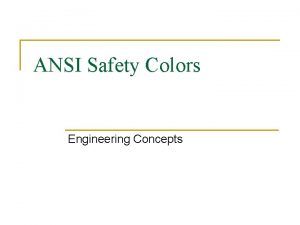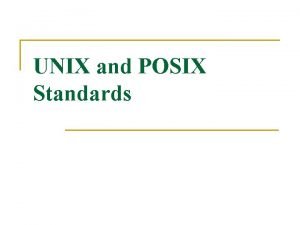ANSI Standard N 43 1 2011 Radiation Safety

- Slides: 1

ANSI Standard N 43. 1 (2011): "Radiation Safety for the Design and Operation of Particle Accelerators" 1 Liu and James C. Lawrence S. 1. SLAC National Accelerator Laboratory, CA, USA 2. Brookhaven National Laboratory, NY, USA 2. Major Elements 1. Introduction ANSI: American National Standard Institute New ANSI N 43. 1 published in November 2011 N 43. 1 was developed to address the hazards and controls for accelerators in current technical, operational and regulatory environment. Goal: provide a consistent and sound radiation protection framework for accelerator community. Chapter 1 — Purpose, Scope and Introduction Chapter 2 — Acronyms, Abbreviations, and Definitions Chapter 3 — Radiation Safety Program 3. 1 General 3. 2 Organization and Administration 3. 4 Design and Implementation of Safety Controls and Monitoring 3. 5 Accelerator Operations 3. 6 Operational Radiation Safety 3. 7 Training and Qualification 3. 8 Program Review and Performance Evaluation 3. 9 Quality Assurance, Quality Control, and Configuration Control 3. 10 Document and Record Management 1. Covers most fixed, non-medical accelerators and encompassing almost all particles types and energies. 2. Covers all phases of accelerator facility from design to decommissioning (life-cycle approach). 3. Addresses both technical and managerial aspects of radiation safety program. 4. Sets both requirements and recommends for the protection of workers, public and environment. 5. Takes a graded approach for hazard control that is commensurate with risk. 6. Addresses engineered and/or interlocked safety systems that provide prompt radiation protection and safe accelerator operations. Chapter 4 — Radiation Safety System (RSS) 4. 1 General 4. 2 Features of the Radiation Safety System (RSS) 4. 3 Requirements and Guidance 4. 4 Radiation Not Related To Accelerator Beam 4. 5 Induced Radioactivity Chapter 5 — Access Control System (ACS) 5. 1 Purposes 5. 2 Graded Approach 5. 3 System Features 5. 4 Beam Inhibiting Devices (BIDs) 5. 5 Interlocks 5. 6 Review 5. 7 Certification and Checks Chapter 6 — Radiation Control System (RCS) 6. 1 General 6. 2 Performance Requirements 6. 3 Passive Systems: Shielding and Fences 6. 4 Active Systems 6. 5 Administrative Controls Appendices Appendix 2 Walker A — Development of Safety Assessment Document (SAD) B — Interlocked-Type Access Control Systems C — Decommissioning Program D — Measurements of Radiation and Radioactivity Normative Appendix E — Safety Standards for Commercially Available and/or Production-Type Accelerators Chapter 7 — Accelerator Operations 7. 1 General 7. 2 Readiness Review 7. 3 Operating Practices 7. 4 Testing, Routine Maintenance and Unscheduled Repairs 7. 5 Interlock Bypasses and Deviations from Procedures 7. 6 Emergency Response Chapter 8 — Operational Radiation Safety 8. 1 General 8. 2 Area Classification, Worker Classification and Access Control 8. 3 Personnel Dosimetry 8. 4 Area Monitoring 8. 5 Radiation Surveys 8. 6 Radiological Work Control 8. 7 Control of Induced Radioactivity 8. 8 Instrumentation 8. 9 Management of Radioactive Material, Sources and Waste 8. 10 Radiological Environmental Protection 8. 11 Facility Cleanup and Decommissioning Chapter 9 — Training 9. 1 General 9. 2 Procedures and Records 9. 3 Training Requirements 9. 4 Radiation Safety Training Program 9. 5 Training Topics 9. 6 Trainer Qualifications Supported by US DOE Contract Number DE-AC 0276 SF 00515 Contact: james@slac. stanford. edu

